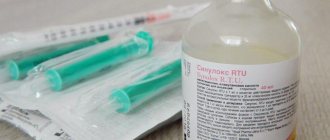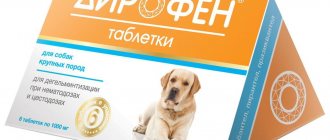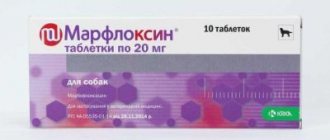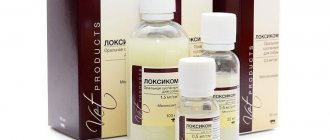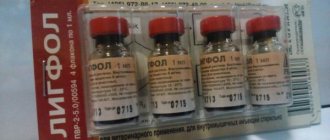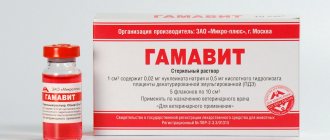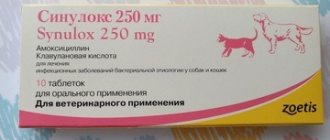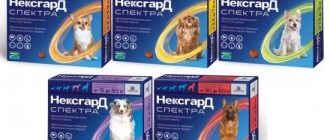Release form
- Tablets for oral use. They are pinkish in color and contain 40 mg of amoxicillin trihydrate.
- Suspension for injection, includes active ingredient and auxiliary components. It has a yellowish color and opalescents when exposed to light. During storage, it settles into sediment; before putting it into a syringe, the bottle must be shaken.
Few pets will willingly eat a bitter-tasting tablet. Therefore, veterinarians most often prescribe Sinulox to dogs by injection.
General information about the drug
A broad-spectrum antibiotic is detrimental to many types of gram-positive and gram-negative microorganisms. Amoxicillin inhibits the activity of clostridia, peptostreptococci, staphylococci, streptococci and other bacteria.
The drug Sinulox is effective in the form of suspension, injections and tablets. The medicine is prescribed by a veterinarian after making a diagnosis and determining the type of pathogen. An antibiotic of the penicillin series is used to treat bacterial infections in domestic animals (cats and dogs), cattle, and pigs.
Indications for use
- Infections of the genitourinary system.
- Respiratory diseases.
- Diseases of the nasal and oral cavity with the participation of bacterial microflora.
- Pathologies of soft tissues contaminated with microorganisms.
Synulox in the form of injections is indicated for abdominal surgeries and various manipulations where there is a risk of developing an inflammatory process.
The drug is not prescribed in the presence of a viral infection. In the treatment of influenza, plague, etc. it will be useless.
It is not recommended to use an antibiotic as a prophylactic agent or to independently calculate the course of treatment. The animal's body quickly gets used to the drug. In the future, if there is an urgent need for antibacterial treatment, the medicine simply will not work on pathogenic bacteria.
It shows itself well against purulent pathologies caused by steptococci, pasteurella, staphylococci, clostridia and others. Acts as a warning factor for soft tissue injuries and prevents the development of purulent infection in the postoperative period.
Analogs
To combat gram-negative and gram-positive organisms, several groups of broad-spectrum antibiotics are used. The optimal type of drug is selected by a veterinarian after studying the medical history, health status, severity of the pathology, taking into account the animal’s age, restrictions and other factors.
Effective analogues of Sinulox for use in veterinary medicine:
- Augmentin.
- Amoxiclav.
- Flemoclav.
- Bayoclav.
Operating principle
Sinulox belongs to the group of penicillins. The main components of Sinulox (amoxicillin, clavulanic acid) work in combination and kill drug-sensitive bacteria
The mechanism of action is to disrupt the synthesis of bacterial cell wall mucopeptide, as a consequence of the death of the pathogenic microorganism. Otherwise, it prevents the activity of microscopic forms of bacteria against the antibiotic. Clavulanic acid in the composition of the drug provides protection to the main active ingredient.
When consumed in tablet form, it is quickly absorbed in the dog's gastrointestinal tract. The therapeutic dose lasts up to 12 hours, which allows you to prescribe the drug up to 2 times a day.
Description of the drug
Sinulox is an antibacterial pharmacological agent with complex action, created on the basis of a unique formula. Available in the form of round pink tablets of 50-250-500 mg, each of which has a dividing groove on one side and the inscription “Synulox” engraved on the other. The veterinary drug is packaged in cardboard boxes of 10 tablets each, packed in aluminum blisters.
Sinulox in tablets of 500 mg is produced packaged in blisters of two pieces, which are placed in cardboard boxes of five blisters.
recommended articles:
- Lyme disease in dogs
- Lice and lice in dogs
Sinulox tablets 50 mg
The box contains the name of the drug, the batch number, manufacturer, date of manufacture, expiration date, method of use, content of active ingredients, and the inscription “For animals.”
The main active ingredients are amoxicillin trihydrate (40 mg, 250 mg) and clavulanic acid in the form of sodium salt (10, 50 mg). The dosage of the active ingredients depends on how many mg the tablet has. In addition, each pill contains auxiliary components: erythrazine, anhydrous colloidal silicon, dry yeast, microcrystalline cellulose, sodium glycolate.
Sinulox is stored in a dry, dark place, protected from sunlight, in cardboard boxes at a temperature of 0-22 degrees. If storage conditions are met, the shelf life is two years, after which the medicine should be discarded. Before use, read the instructions for the drug and follow the dosage recommended by your veterinarian.
Sinulox tablets 250 mg
Instructions for use
According to the instructions, the antibiotic in dry form is prescribed at 12 mg/kg of the dog’s live weight, injections – 9 mg/kg. The effect of a single injection of the drug is designed for 12 hours, after this time Sinulox is re-administered.
Taking pills
Tablets without flavoring additives, with a pronounced bitter taste. The dog will voluntarily refuse to eat the drug. You can crush the tablet into powder, mix it with minced meat and offer it to your pet. A more complex, but immediate method is to open the mouth, place the tablet on the root of the tongue and slightly push the medicine inside, while simultaneously closing the dog’s jaw. Raise your head, stroking your neck from top to bottom to stimulate the swallowing movement.
It is better not to follow recommendations to crush the medicine into powder and mix with water. Liquid may enter the respiratory tract. The dog may choke by reflexively coughing up the water containing the medicine.
Use of suspension
Shake the bottle thoroughly before use. Draw the suspension into a syringe and inject it subcutaneously or intramuscularly before the fractions settle again. It is not recommended to fill the syringe in advance; there is a danger of injecting liquid without the main substance.
Bottles are available in 40 and 100 ml, they are enough for several uses. The suspension is stored tightly closed with a ground-in rubber stopper in a dark place at room temperature. On average, injections are prescribed for 5-7 days, but in severe cases the course can last up to 2 weeks.
The frequency of injection use is once every 12 hours, for severe bacterial infections, once every 8 hours.
After the end of the course of injections, the bottle with the remaining antibiotic is thrown away. Do not store open medicine.
The injection site of the antibiotic is thoroughly warmed up (kneaded) to avoid the formation of a lump.
Never mix several medications in one syringe, as this may cause unpredictable reactions.
Application of ampoules
Sinulox 3 g has the form of a syringe; according to the method of application, the drug is identical to the suspension. There is no need to shake it, the dosage is 12.5 mg/kg body weight (1 ml/20 kg body weight). An open ampoule is stored for up to 4 days; after completion of the course of treatment, the opened drug is disposed of.
Suspension-based therapy
Sinulox injections for cats are carried out using a liquid solution. Injections are usually placed in the withers of a four-legged pet or subcutaneously, less often in the gluteal muscle. The therapeutic regimen involves 1 injection per day for 3–5 days. However, the course of treatment can be extended by a veterinarian if the disease is difficult to eliminate. It is recommended to lightly massage the place where the medication was injected, which will ensure its better distribution throughout the body and the pet will not feel discomfort.
Immediately before the injection of an antibiotic, its dosage is correctly calculated. Thus, the instructions indicate that no more than 8.75 mg of the active substance should be used per 1 kg of animal weight. This equates to 1 ml of solution per 20 kg of total weight.
When it comes to cats with low weight, their owners find it difficult and cannot correctly calculate the required amount of suspension. In this case, experts recommend using an insulin syringe with suitable marks. When performing antibiotic injections, the following rules must be strictly observed:
- It is prohibited to administer Sinulox solution directly into a vein;
- before use, the bottle with the suspension is thoroughly shaken until a homogeneous consistency is obtained;
- Only a sterile syringe and needle are used, hands are first washed with soap.
Expected Side Effects
The course of antibiotics should not be exceeded; this leads to pseudomembranous colitis and cholestatic jaundice. Often side effects appear after the end of the course of therapy. This confuses both the breeder and the specialist; new treatment is often prescribed to eliminate pseudo-diseases. Therefore, we must not forget about the long-term consequences.
In case of overdose the following are observed:
- Gastrointestinal upset (diarrhea, vomiting, refusal to feed).
- Drowsiness, lethargy.
- Skin lesions due to incorrect injection (ulcers, swelling, rashes).
An overdose can further weaken the dog, requiring immediate attention to a veterinarian. It is necessary to take antihistamines and corticosteroids if symptoms last longer than a day.
Side effects and contraindications
The drug Sinulox, which belongs to the penicillin group, has prohibitions in the form of an allergic reaction to antibiotics and individual intolerance to any of the components included in the composition. The medication should not be used on cats that are undergoing therapy based on bacteriostatic agents during this period.
As for side effects, they are extremely rare and few in number. If the exact dosage is not followed by the veterinarian or pet owner, the following reactions are sometimes observed in sensitive animals:
- rashes on the skin of varying intensity;
- increased lacrimation;
- impaired functioning of the digestive system, manifested by difficult bowel movements or diarrhea;
- severe swelling of the mucous membranes and skin.
If an animal being treated with an antibiotic exhibits these symptoms, it should be taken to a veterinarian immediately. The specialist must adjust the dosage of the drug or replace it with a more suitable analogue. Mild symptoms often go away on their own.
Analogues and shelf life
There is an equally effective analogue of Sinulox. But in the absence of the main drug, you cannot independently change it to similar active ingredients. Moreover, based on reviews on the Internet.
The veterinarian can replace Sinulox with:
- Amoxiclav.
- Xiclav.
- Norclave.
- Honeyclave.
- Flemoclav.
- Augmentin.
- Amoxicillin.
All drugs contain a combination of amoxicillin and clavulanic acid; the “human” versions are in no way inferior in effectiveness to the veterinary drug. However, without explanation from the attending physician, it cannot be dosed based on human instructions.
The cost of Synulox is from 300 rubles in the Russian Federation. The shelf life of any unopened form is no more than 2 years from the date of production. The drug is kept at room temperature in a dark place.
Medicines with similar effects
Pet owners often wonder if Synulox has analogues for cats, despite a lot of positive reviews about it. It is allowed to use other medications based on amoxicillin instead of this drug. A similar active substance is present in Noroklav, Flemoklav, Amoxiclav.
Some of these products can be purchased at a regular pharmacy if it is not possible to visit a veterinary clinic. In any case, priority remains with a medicine developed specifically for pets.
Reviews
Vasily, 35 years old, Moscow
Sinulox has shown excellent results in the treatment of severe pneumonia. The dog began to feel better literally within a week. We keep the drug in reserve in the first aid kit, it’s an excellent remedy.
Marina, 46 years old, Irkutsk
My dog is almost 11 years old. For the last three years he has been suffering from cystitis, the disease worsens when the snow melts and in the fall. The veterinarian prescribed Sinulox; I had long doubts about using an antibiotic for an old dog. But I made up my mind and am pleased with the result, progress in treatment after 5 days.
